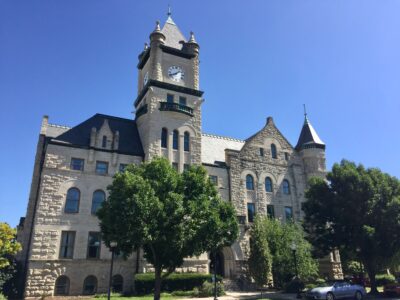Leaders say Douglas County’s crisis center is having problems with sending patients to hospitals for longer-term care

photo by: Matt Resnick | Journal-World
Treatment and Recovery Center Medical Director Cord Huston, second from right, discusses challenges related to patient referrals during the Douglas County Commission work session on Wednesday, Nov. 1, 2023.
Every day, Douglas County’s new behavioral health crisis center has one or two patients who could benefit from longer-term treatment at a psychiatric hospital like Osawatomie State Hospital — but it can’t send them there because of a lack of beds and the hospitals’ guidelines for which patients they accept.
That’s what local mental health leaders from the Treatment and Recovery Center of Douglas County and Bert Nash Community Mental Health Center, which operates it, told county commissioners at a work session on Wednesday. TRC Medical Director Cord Huston said that Osawatomie, the nearest state hospital, typically has a long wait list for beds, and that patients must often wait for weeks in Douglas County’s facilities until a long-term bed at any other facility becomes available.
That’s if a facility will even accept the patients in the first place. Huston said Osawatomie normally only does involuntary admissions, and that the TRC’s attempts to give patients voluntary referrals to the hospital are routinely rejected.
“The reality is, folks don’t want to take our patients,” said Stephen O’Neill, Bert Nash chief operations officer. “We are managing a level of (severe cases) at our crisis center that the hospitals don’t want to manage. These hospitals don’t have an agreement that says they can’t turn people away — so they do.”
The TRC, which opened in April, isn’t designed to provide patients with long-term treatment like a state psychiatric hospital is; it’s designed for inpatient stays of up to 72 hours. For most of the nearly 800 patients the facility has served so far, that’s not been a problem; the statistics presented to the commission on Wednesday showed that the average time that patients stay at the TRC is around two days.
Commissioner Karen Willey asked how many patients were “currently in the bottleneck, either in our emergency department or in the TRC, that are waiting on a bed.” TRC Director Bri Harmon-Moore said she didn’t have a specific number, but that the TRC is “always at least involved with one or two (patients) a day that we’re trying to find something for, either within our facility or LMH.”
Harmon-Moore added that other facilities will often reject referrals because of the severity of a patient’s case. That could be because of either their mental health or their physical health, O’Neill said. And Bert Nash CEO Patrick Schmitz said that facilities’ admission criteria can be complex and that they can even “vary from week to week.”
These referral problems aren’t unique to the TRC, O’Neill told the Journal-World.
“I imagine if you called any community mental health center in the state, that they would give you the same story,” he said.
For now, the TRC is doing its best to accommodate patients who need longer-term care. O’Neill told the Journal-World that although the facility’s goal is to get patients “back home to the community or to another facility” within 72 hours, it won’t “discharge folks until they have a place to go.”
Commission Chair Patrick Kelly said the TRC was going above and beyond by treating patients who exceed the short-term stays, and that “we take that on because of our compassion.”
Looking at the long term, the TRC and Bert Nash officials said, there might not be a solution to the bottleneck unless more hospitals are built. Schmitz hopes that will happen in the near future. He said he’s heard about plans for a 50-bed psychiatric hospital in the Wichita area, and that a facility in the Kansas City metro area might be built at some point.
“Our need, right now, is that getting somebody to any of the other facilities is very challenging,” Schmitz said.
• • •
Commissioners also heard more information about the TRC’s finances for the 2023 and 2024 budget years, including how the TRC is dealing with lower-than-expected revenue.
The center’s revenue for 2023 is now projected to be about $6.8 million, O’Neill said — $2 million less than what it originally expected in its budget. But he said that the TRC was spending less than it expected, too.
The primary reason for that has to do with changes to Bert Nash’s health insurance plan for employees, he said. O’Neill also said pharmacy costs have been lower than expected, as have costs for security and cleaning services.
The 2024 budget, meanwhile, has been revised to be about $1.1 million larger than it previously was. It’s currently set at $11.5 million, but O’Neill said that wasn’t necessarily the final figure because the center was still working out some details with the state.
“We are still in negotiations with the state, and realistically cannot complete a TRC or Bert Nash budget until those negotiations are final,” he said.
The officials also gave the commission a report about the center’s performance metrics for the year, including such areas as community walk-ins; acceptance of patients dropped off by law enforcement; and referrals that the TRC accepted from other organizations. Harmon-Moore said the center had met most of its targets. Kelly was pleased with these statistics, and he said “we really need to celebrate the progress you’ve made in a short amount of time.”
“I’ll be honest — this exceeded my expectations,” Kelly said.
In other business, the commission:
• Unanimously voted to prequalify two area contractors, B.A. Green Construction and Icon Structures, for “on-call contractor services” for small or medium-sized construction projects. Those companies are now the first two names on the county’s list of “on-call contractors.”




